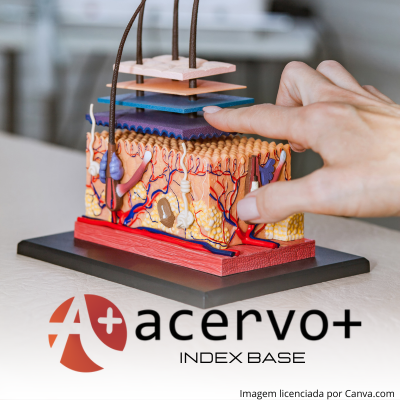Morfofisiologia da pele e o processo de envelhecimento cutâneo
##plugins.themes.bootstrap3.article.main##
Resumo
Objetivo: Este trabalho objetivou descrever a morfofisiologia da pele e o processo do envelhecimento cutâneo. Revisão bibliográfica: A pele é o maior órgão do corpo humano e além de proteção, desempenha diversas funções fisiológicas. Com o passar dos anos, tende a entrar no processo de envelhecimento natural, porém, alguns agentes externos ao corpo podem acelerar esse envelhecimento e provocar um aparecimento antecipado das rugas e flacidez, característicos do envelhecimento. Os sinais e características do envelhecimento da pele se dão principalmente pela degradação das fibras de colágeno, onde sua ausência provoca uma perda de preenchimento da matriz extracelular e a perda das fibras elásticas, fazendo com que o tecido perda elasticidade. Considerações finais: Entre os fatores indutores extrínsecos ao corpo, estão a exposição aos raios solares, tabaco, poluição e má alimentação, esses fatores, levam a formação de espécies reativas de oxigênio e essas espécies ativam cascatas de reações que degradam fibras de colágeno e fibras elásticas induzindo assim o envelhecimento precoce da pele.
##plugins.themes.bootstrap3.article.details##
Copyright © | Todos os direitos reservados.
A revista detém os direitos autorais exclusivos de publicação deste artigo nos termos da lei 9610/98.
Reprodução parcial
É livre o uso de partes do texto, figuras e questionário do artigo, sendo obrigatória a citação dos autores e revista.
Reprodução total
É expressamente proibida, devendo ser autorizada pela revista.
Referências
2. ARAVIISKAIA E, et al. The impact of airborne pollution on skin. Journal of the European Academy of Dermatology and Venereology, 2019; 33(8): 1496-1505.
3. ARIOTTI S, VELDHOEN M. Immunology: Skin T Cells Switch Identity to Protect and Heal. Current Biology, 2019; 29(6): 220-223.
4. BOLKE L, et al. A Collagen Supplement Improves Skin Hydration, Elasticity, Roughness, and Density: Results of a Randomized, Placebo-Controlled, Blind Study. Nutrients, 2019; 11(10): 2494.
5. CHEN Q, et al. Metformin Attenuates UVA-Induced Skin Photoaging by Suppressing Mitophagy and the PI3K/AKT/mTOR Pathway. International Journal of Molecular Sciences, 2022; 23(13): 6960
6. COLE MA, et al. Extracellular matrix regulation of fibroblast function: redefining our perspective on skin aging. Journal of Cell Communication and Signaling, 2018; 12(1): 35-43.
7. CSEKES E, RAˇCKOVÁ, L. Skin Aging, Cellular Senescence and Natural Polyphenols. International Journal of Molecular Sciences, 2021; 22(23): 12641.
8. CUI Y, et al. Rejuvenation of Aged Human Skin by Injection of Cross-linked Hyaluronic Acid. Plastic and Reconstructive Surgery, 2021; 147(1S-2): 43S-49S.
9. HEINZ A. Elastic fibers during aging and disease. Ageing Research Reviews, 2021; 66: 101255.
10. HO CY, DREESEN O. Faces of cellular senescence in skin aging. Mechanisms of Ageing and Development, 2021; 198: 111525.
11. JUNQUEIRA LCU, CARNEIRO J. Histologia básica: texto e atlas. 13 ed. Rio de Janeiro: Guanabara Koogan, 2017; 554.
12. LAING S, et al. Dermonutrient Containing Special Collagen Peptides Improves Skin Structure and Function: A Randomized, Placebo-Controlled, Triple-Blind Trial Using Confocal Laser Scanning Microscopy on the Cosmetic Effects and Tolerance of a Drinkable Collagen Supplement. Journal of Medicinal Food, 2020; 23(2): 147-152.
13. LUBOV JE, et al. The Impact of the Circadian Clock on Skin Physiology and Cancer Development. International Journal of Molecular Sciences, 2021; 22(11): 6112.
14. LORZ LR, et al. Anti-Wrinkling and Anti-Melanogenic Effect of Pradosia mutisii Methanol Extract. International Journal of Molecular Sciences, 2019; 20(5): 1043.
15. MARINHO A, et al. Hyaluronic Acid: A Key Ingredient in the Therapy of Inflammation. Biomolecules, 2021; 11(10): 1518.
16. NGUYEN AV, SOULIKA AM. The Dynamics of the Skin’s Immune System. International Journal of Molecular Sciences, 2019; 20(8): 1811.
17. RITTIÉ L, FISHER GJ. Natural and Sun-Induced Aging of Human Skin. Cold Spring Harbor Perspectives in Medicine, 2015; 5(1): a015370.
18. ROGER M, et al. Bioengineering the microanatomy of human skin. Journal of Anatomy, 2019; 234(4): 438-455.
19. SHIN JW, et al. Molecular Mechanisms of Dermal Aging and Antiaging Approaches. International Journal of Molecular Sciences, 2019; 20(9): 2126.
20. SUZUKI S, et al. Inhibition of melanin production and promotion of collagen production by the extract of Kuji amber. Bioscience, Biotechnology and Biochemistry, 2020; 84(3): 518-525.
21. SCHMELZER EH, DUCA L. Elastic fibers: formation, function, and fate during aging and disease. The FEBS Journal, 2022; 289(13): 3704-3730.
22. SCARANO A, et al. The role of hyaluronic acid and amino acid against the aging of the human skin: A clinical and histological study. Journal of Cosmetic Dermatology, 2021; 20(7): 2296-2304.
23. WOHLRAB J, et al. Epidermale Alternsprozesse und Anti-Aging Strategien. Die Dermatologie, 2016; 67: 107-111.

